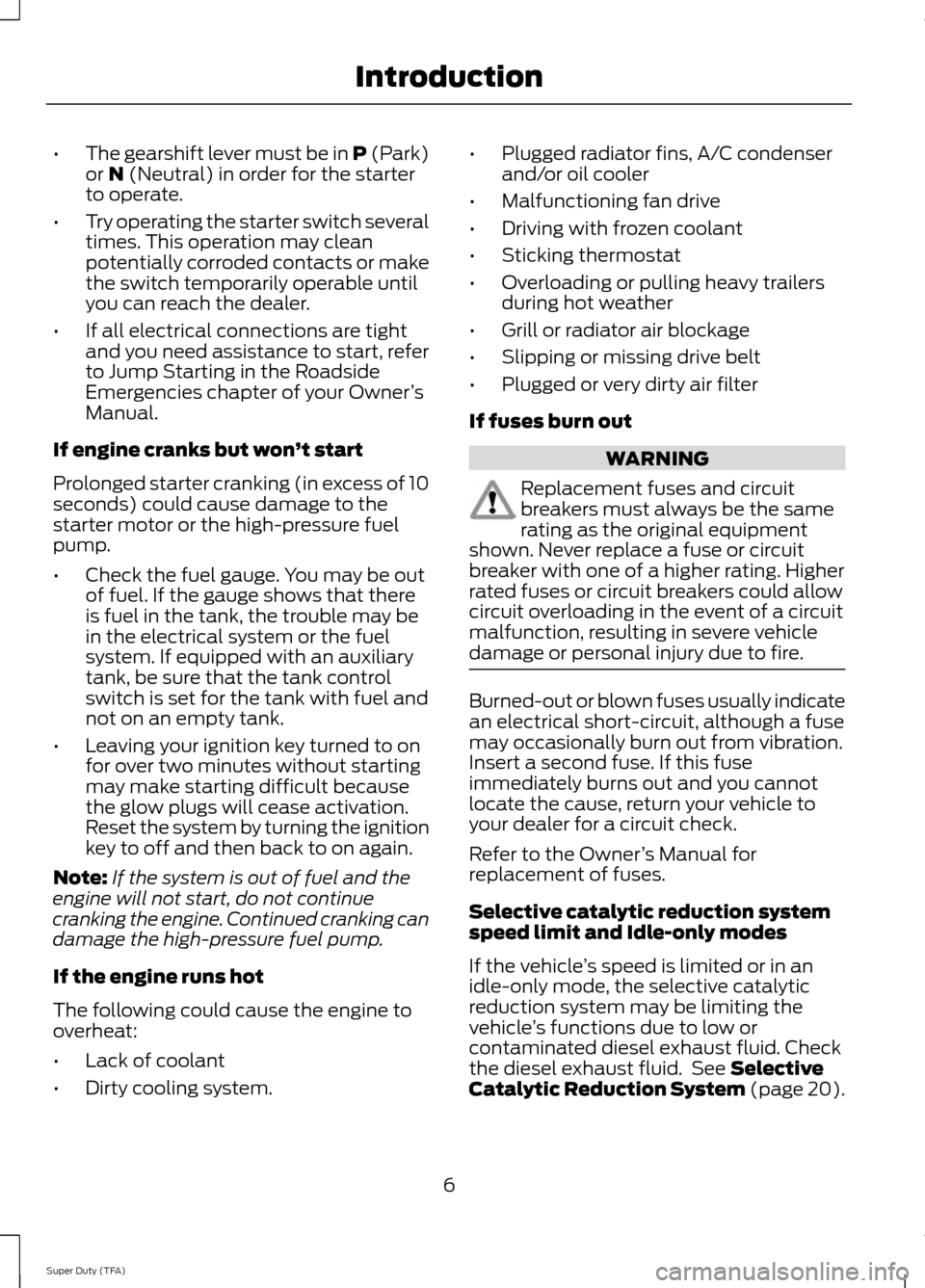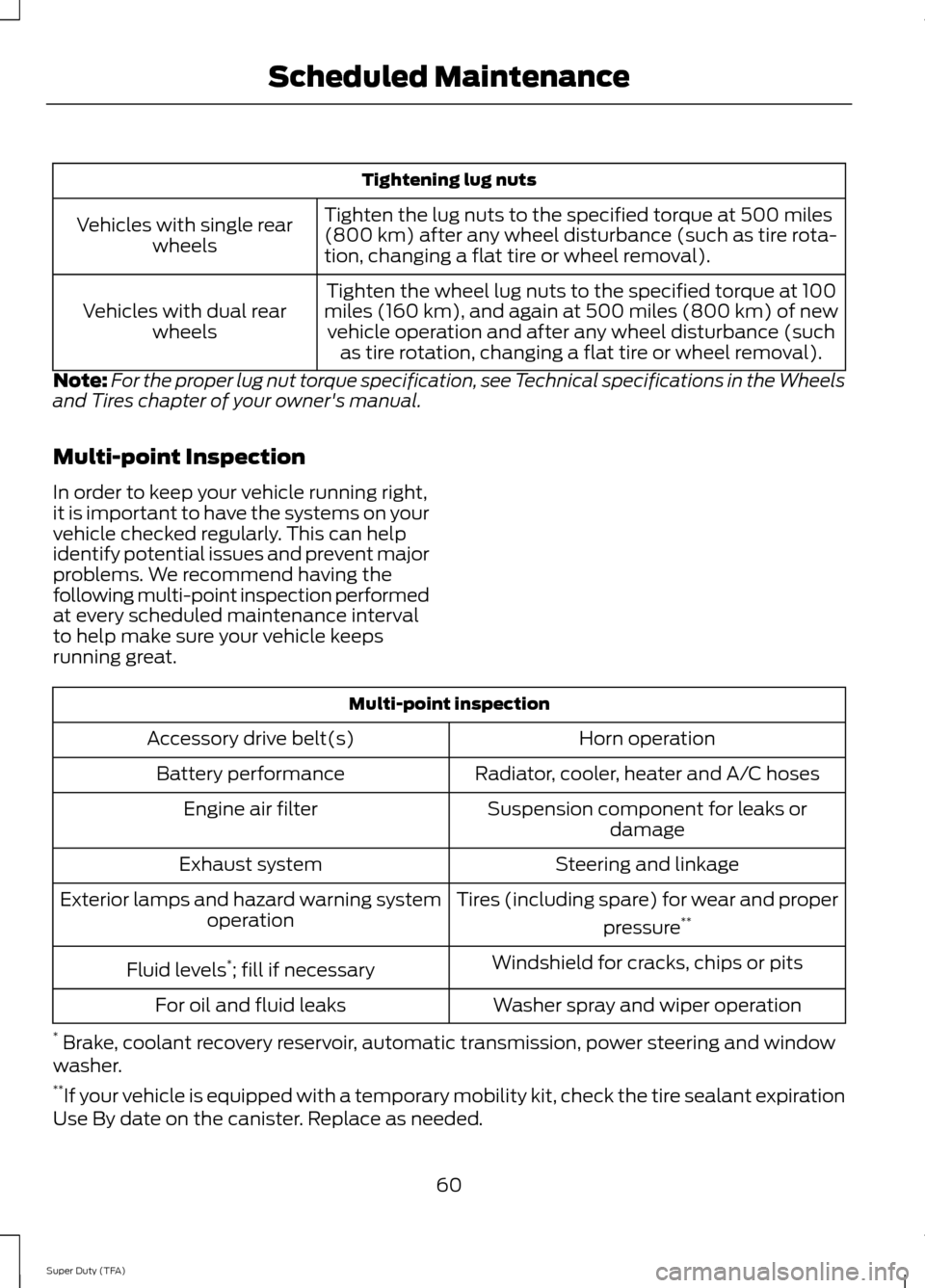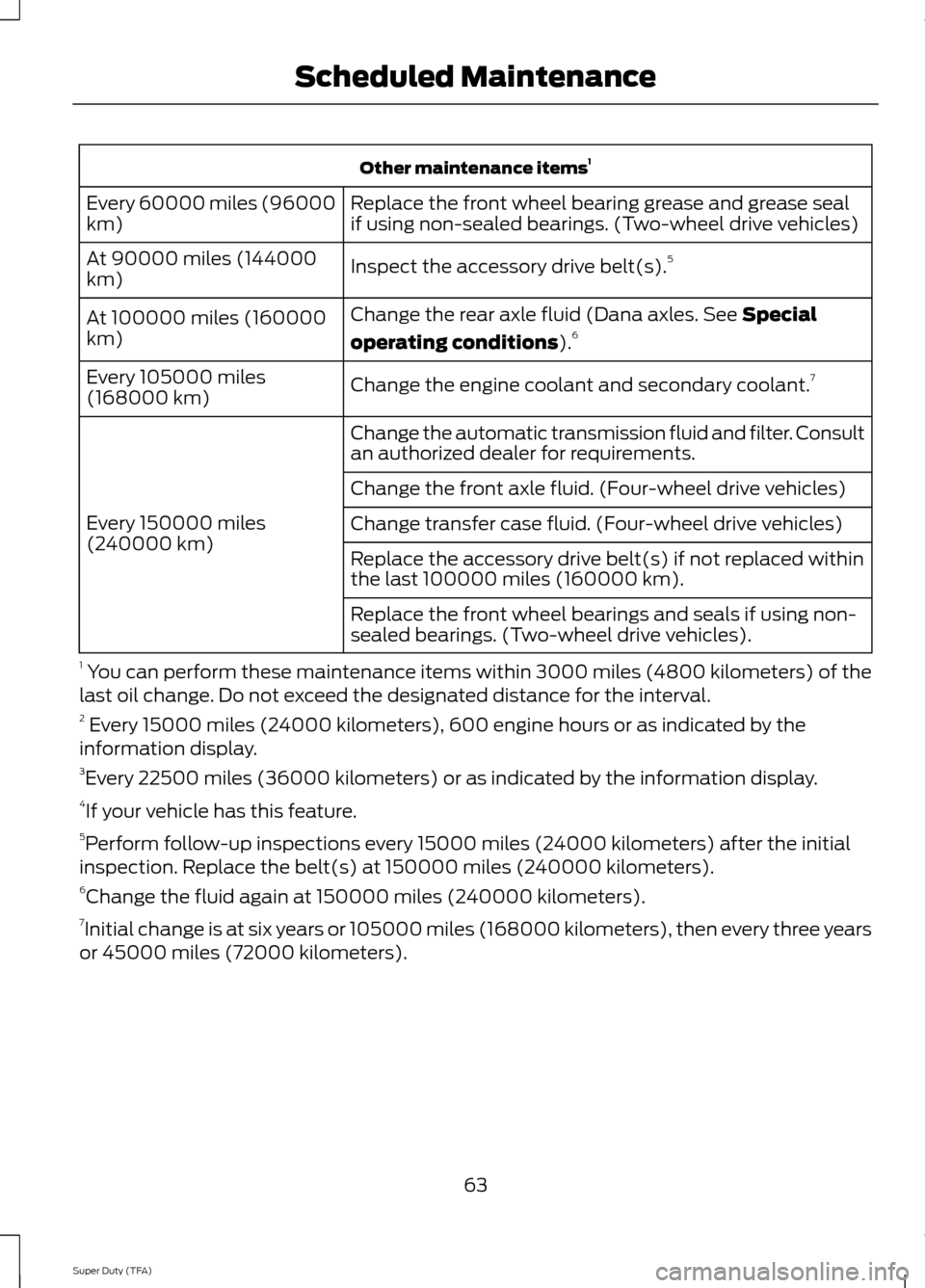belt FORD SUPER DUTY 2014 3.G Diesel Supplement Manual
[x] Cancel search | Manufacturer: FORD, Model Year: 2014, Model line: SUPER DUTY, Model: FORD SUPER DUTY 2014 3.GPages: 82, PDF Size: 3.12 MB
Page 9 of 82

•
The gearshift lever must be in P (Park)
or N (Neutral) in order for the starter
to operate.
• Try operating the starter switch several
times. This operation may clean
potentially corroded contacts or make
the switch temporarily operable until
you can reach the dealer.
• If all electrical connections are tight
and you need assistance to start, refer
to Jump Starting in the Roadside
Emergencies chapter of your Owner ’s
Manual.
If engine cranks but won ’t start
Prolonged starter cranking (in excess of 10
seconds) could cause damage to the
starter motor or the high-pressure fuel
pump.
• Check the fuel gauge. You may be out
of fuel. If the gauge shows that there
is fuel in the tank, the trouble may be
in the electrical system or the fuel
system. If equipped with an auxiliary
tank, be sure that the tank control
switch is set for the tank with fuel and
not on an empty tank.
• Leaving your ignition key turned to on
for over two minutes without starting
may make starting difficult because
the glow plugs will cease activation.
Reset the system by turning the ignition
key to off and then back to on again.
Note: If the system is out of fuel and the
engine will not start, do not continue
cranking the engine. Continued cranking can
damage the high-pressure fuel pump.
If the engine runs hot
The following could cause the engine to
overheat:
• Lack of coolant
• Dirty cooling system. •
Plugged radiator fins, A/C condenser
and/or oil cooler
• Malfunctioning fan drive
• Driving with frozen coolant
• Sticking thermostat
• Overloading or pulling heavy trailers
during hot weather
• Grill or radiator air blockage
• Slipping or missing drive belt
• Plugged or very dirty air filter
If fuses burn out WARNING
Replacement fuses and circuit
breakers must always be the same
rating as the original equipment
shown. Never replace a fuse or circuit
breaker with one of a higher rating. Higher
rated fuses or circuit breakers could allow
circuit overloading in the event of a circuit
malfunction, resulting in severe vehicle
damage or personal injury due to fire. Burned-out or blown fuses usually indicate
an electrical short-circuit, although a fuse
may occasionally burn out from vibration.
Insert a second fuse. If this fuse
immediately burns out and you cannot
locate the cause, return your vehicle to
your dealer for a circuit check.
Refer to the Owner
’s Manual for
replacement of fuses.
Selective catalytic reduction system
speed limit and Idle-only modes
If the vehicle ’s speed is limited or in an
idle-only mode, the selective catalytic
reduction system may be limiting the
vehicle ’s functions due to low or
contaminated diesel exhaust fluid. Check
the diesel exhaust fluid. See
Selective
Catalytic Reduction System (page 20).
6
Super Duty (TFA) Introduction
Page 57 of 82

ENGINE SPECIFICATIONS
Drivebelt Routing
Single Alternator
Dual Alternator
MOTORCRAFT PARTS
Ford Part Number
Component
FL-2051
Engine oil filter
FA-1907
Foam pre-
filter
FA-1902
Air filter 1
54
Super Duty (TFA) Capacities and SpecificationsE163381 E163382
Page 63 of 82

Tightening lug nuts
Tighten the lug nuts to the specified torque at 500 miles
(800 km) after any wheel disturbance (such as tire rota-
tion, changing a flat tire or wheel removal).
Vehicles with single rear
wheels
Tighten the wheel lug nuts to the specified torque at 100
miles (160 km), and again at 500 miles (800 km) of new vehicle operation and after any wheel disturbance (such as tire rotation, changing a flat tire or wheel removal).
Vehicles with dual rear
wheels
Note: For the proper lug nut torque specification, see Technical specifications in the Wheels
and Tires chapter of your owner's manual.
Multi-point Inspection
In order to keep your vehicle running right,
it is important to have the systems on your
vehicle checked regularly. This can help
identify potential issues and prevent major
problems. We recommend having the
following multi-point inspection performed
at every scheduled maintenance interval
to help make sure your vehicle keeps
running great. Multi-point inspection
Horn operation
Accessory drive belt(s)
Radiator, cooler, heater and A/C hoses
Battery performance
Suspension component for leaks ordamage
Engine air filter
Steering and linkage
Exhaust system
Tires (including spare) for wear and properpressure**
Exterior lamps and hazard warning system
operation
Windshield for cracks, chips or pits
Fluid levels *
; fill if necessary
Washer spray and wiper operation
For oil and fluid leaks
* Brake, coolant recovery reservoir, automatic transmission, power steering and window
washer.
** If your vehicle is equipped with a temporary mobility kit, check the tire sealant expiration
Use By date on the canister. Replace as needed.
60
Super Duty (TFA) Scheduled Maintenance
Page 66 of 82

Other maintenance items
1
Replace the front wheel bearing grease and grease seal
if using non-sealed bearings. (Two-wheel drive vehicles)
Every 60000 miles (96000
km)
Inspect the accessory drive belt(s). 5
At 90000 miles (144000
km)
Change the rear axle fluid (Dana axles. See Special
operating conditions
). 6
At 100000 miles (160000
km)
Change the engine coolant and secondary coolant. 7
Every 105000 miles
(168000 km)
Change the automatic transmission fluid and filter. Consult
an authorized dealer for requirements.
Every 150000 miles
(240000 km) Change the front axle fluid. (Four-wheel drive vehicles)
Change transfer case fluid. (Four-wheel drive vehicles)
Replace the accessory drive belt(s) if not replaced within
the last 100000 miles (160000 km).
Replace the front wheel bearings and seals if using non-
sealed bearings. (Two-wheel drive vehicles).
1 You can perform these maintenance items within 3000 miles (4800 kilometers) of the
last oil change. Do not exceed the designated distance for the interval.
2 Every 15000 miles (24000 kilometers), 600 engine hours or as indicated by the
information display.
3 Every 22500 miles (36000 kilometers) or as indicated by the information display.
4 If your vehicle has this feature.
5 Perform follow-up inspections every 15000 miles (24000 kilometers) after the initial
inspection. Replace the belt(s) at 150000 miles (240000 kilometers).
6 Change the fluid again at 150000 miles (240000 kilometers).
7 Initial change is at six years or 105000 miles (168000 kilometers), then every three years
or 45000 miles (72000 kilometers).
63
Super Duty (TFA) Scheduled Maintenance
Page 80 of 82

A
About This Supplement.................................3
Breaking-In Your Vehicle...................................... 3
Diesel Engine Information................................... 3
Minor Troubleshooting Guide............................. 5
Warnings.................................................................... 3
ABS See: Brakes............................................................. 36
B
Brakes.................................................................36 General Information............................................ 36
C
Capacities and Specifications..................54 Technical Specifications................................... 56
Changing the Engine Air Filter
...................49
Air Filter Replacement....................................... 50
Air Filter Restriction Gauge............................... 49
Cleaning the Engine......................................53
Cleaning the Exhaust
....................................53
Coolant Check See: Engine Coolant Check.............................. 44
E
Emission Control System............................29 Diesel Exhaust System: Oxidation Catalyst
And Diesel Particulate Filter System
........................................................................\
........ 29
Engine Block Heater.......................................13 Rapid Heat Supplemental Heating
System.................................................................. 13
Engine Coolant Check..................................44 Adding Engine Coolant...................................... 44
Checking Coolant Corrosion Inhibitor Additive Strength ............................................ 47
Checking the Engine Coolant.......................... 44
Coolant Change.................................................... 49
Engine and Secondary Cooling System Refill Procedure............................................... 46
Engine-driven Cooling Fan (Fan Clutch)................................................................ 49
Recycled Engine Coolant................................... 47
Severe Climates.................................................... 47Engine Idle Shutdown....................................12
Engine Oil Check.............................................42
Changing the Engine Oil and Oil Filter.........43
Engine Oil Specifications.................................. 42
Engine Specifications
...................................54
Drivebelt Routing................................................. 54
F
Fuel and Refueling
..........................................14
Fuel Quality.......................................................14
Biodiesel................................................................... 15
Diesel Fuel Additives ........................................... 16
Fuel And Water Separator ................................ 16
Fuel Requirements - Choosing The Right Fuel: Vehicles Operated Where Ultra Low
Sulfur Diesel Fuel Is Not Required ............14
Fuel Requirements - Choosing The Right Fuel: Vehicles Operated Where Ultra Low
Sulfur Diesel Fuel Is Required (United
States/Canada/Puerto Rico/U.S. Virgin
Islands And Other Locales) ......................... 14
Fuel Shutoff
.....................................................38
Running Out Of DEF (Diesel Exhaust
Fluid).................................................................... 38
Fuel Tank Selector Switch..........................35
G
Gauges..................................................................7 Engine Boost Gauge............................................... 7
General Maintenance Information..........58 Multi-point Inspection....................................... 60
Owner Checks and Services............................ 59
Protecting Your Investment............................. 58
Why Maintain Your Vehicle?............................ 58
Why Maintain Your Vehicle at Your Dealership?....................................................... 58
I
Instrument Cluster
............................................7
Introduction........................................................3
77
Super Duty (TFA) Index